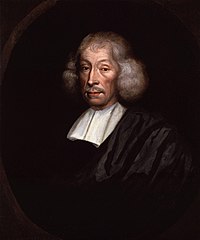
Back جون ري Arabic جون رى ARZ جان ری AZB John Ray Catalan John Ray Czech John Ray CY John Ray Danish John Ray German John Ray EO John Ray Spanish
John Ray | |
|---|---|
 | |
| Born | 29 November 1627 |
| Died | 17 January 1705 (aged 77) Black Notley, Essex, England |
| Nationality | English |
| Alma mater | Trinity College, Cambridge St Catharine's College, Cambridge |
| Scientific career | |
| Fields | Botany, Zoology, Natural history, Natural theology |
| Academic advisors | James Duport |
| Author abbrev. (botany) | Ray |

John Ray FRS (29 November 1627 – 17 January 1705) was a Christian English naturalist widely regarded as one of the earliest of the English parson-naturalists. Until 1670, he wrote his name as John Wray. From then on, he used 'Ray', after "having ascertained that such had been the practice of his family before him". He published important works on botany, zoology, and natural theology. His classification of plants in his Historia Plantarum, was an important step towards modern taxonomy. Ray rejected the system of dichotomous division by which species were classified by repeated sub-division into groups according to a pre-conceived series of characteristics they have or have not, and instead classified plants according to similarities and differences that emerged from observation. He was among the first to attempt a biological definition for the concept of species, as "a group of morphologically similar organisms arising from a common ancestor".[1] Another significant contribution to taxonomy was his division of plants into those with two seedling leaves (dicotyledons) or only one (monocotyledons), a division used in taxonomy today.[2]
- ^ Historia plantarum generalis, in the volume published in 1686, Tome I, Libr. I, Chap. XX, page 40 (Quoted in Mayr, Ernst. 1982. The growth of biological thought: diversity, evolution, and inheritance. Cambridge, Mass.: Belknap Press: 256)
- ^ Atran, Scott (1992). Cognitive Foundations of Natural History: Towards an Anthropology of Science. Cambridge: Cambridge University Press.